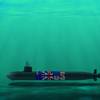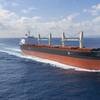By Mass Communication Specialist 1st Class Brandan W. Schulze, Navy Office of Information
The National Marine Fisheries Services issued a final rule Aug. 16 that allows the Navy to continue operating Surveillance Towed Array Sensor System Low Frequency Active (SURTASS LFA) sonar in the western Pacific Ocean for the next five years, subject to a yearly authorization renewal.
SURTASS LFA consists of two separate components. The LFA portion of the system is suspended vertically below the ship and transmits low-frequency sound energy into the water. SURTASS, the passive portion of the system, is towed behind the ship and is made up of a series of underwater microphones that detect natural and man-made sound energy in the water. This allows underwater objects, such as submarines, to be detected.
Deputy Assistant Secretary of the Navy (Environment) Donald R. Schregardus says the ruling "will allow the Navy to continue operations in the western Pacific that are vital to our national defense."
According to Schregardus, the system is vital for use in tracking extremely quiet diesel-electric submarines, which could pose a potential threat to Navy Sailors and ships if they go undetected.
When operating on battery power, these submarines can conduct nearly silent underwater operations. As countries continue to acquire diesel-electric submarines, the Navy makes tracking them a priority.
He said SURTASS LFA is necessary for national security, and is operated in a manner that is environmentally sound. Past research has facilitated the development of science-based mitigation measures that allow the sonar to operate in harmony with the ocean environment. Sonar operators monitor for the presence of marine mammals prior to, during and after sonar activity and either turn off or delay start-up if marine mammals come too close.
Schregardus said that five years of these sonar operations in the western Pacific produced no evidence of any harm to marine mammals or their populations.
Schregardus said claims that SURTASS LFA destroys ocean life and cannot be operated in harmony with the environment are "simply untrue and not supported by scientific fact."
Subscribe for
Maritime Reporter E-News
Maritime Reporter E-News is the maritime industry's largest circulation and most authoritative ENews Service, delivered to your Email five times per week










